Movie Review – Millennium Trilogy, The: The Girl Who Played With Fire
Well crafted detective sequel isn’t as well crafted as the original, nor is it as absorbing from a character point of view, although the broadening of Lisbeth’s history and the disturbing revelations about her past keeps the story ticking along nicely. Fire is well shot, well acted and is effective in its better moments, although unlike its predecessor there’s not as many of them. The secondary cast get a larger cut of the screen-time here, even if they’re often shunted aside by the story’s demand for action. But the focus is on Lisbeth, and she’s the glue that holds this film, and the entire franchise, together. And when she’s not on screen, a lot of the fire goes out of this one.
– Summary –
Director : Daniel Alfredson
Year Of Release : 2009
Principal Cast : Noomi Rapace, Michael Nyqvist, Lena Andre, Peter Andersson, Yasmine Garbi, Paolo Roberto, Georgi Staykov, Micke Spreitz.
Approx Running Time : 129 Minutes
Synopsis: After a year abroad, Lisbeth Salander returns to Sweden to discover that she’s been framed for a triple murder – two journalists and her former guardian (and rapist) have been executed, and the police have her as the prime suspect. Lisbeth’s friend Mikael Blomkvist disbelieves the police story, and sets about trying to uncover the truth – in parallel to Lisbeth’s own investigation elsewhere – and as they dig they begin to uncover a hidden conspiracy that has a direct connection to Lisbeth’s past.
What we think : Well crafted detective sequel isn’t as well crafted as the original, nor is it as absorbing from a character point of view, although the broadening of Lisbeth’s history and the disturbing revelations about her past keeps the story ticking along nicely. Fire is well shot, well acted and is effective in its better moments, although unlike its predecessor there’s not as many of them. The secondary cast get a larger cut of the screen-time here, even if they’re often shunted aside by the story’s demand for action. But the focus is on Lisbeth; she’s the glue that holds this film, and the entire franchise, together. And when she’s not on screen, a lot of the fire goes out of this one.
**********************
I wrote in my original review of The Girl With The Dragon Tattoo, of which this film is the sequel, that lead actress Noomi Rapace seared her performance into your memory, and if that was the opening salvo, her return serve in this flick is indeed worthy of inclusion under the label of awesome. Lisbeth Salander is a terrific cinematic character, the kind of person with plenty of deep dark secrets and buried rage just waiting to bubble up. Her journey, through the previous film and this one, seems to be getting darker, as her past starts to rear up its ugly head. The continued through-line of these films is perhaps the most interesting aspect, as facets of the previous film come into play here, and I’ve no doubt that the third film, The Girl Who Kicked The Hornet’s Nest, will continue that trend. It’s a semi-serialized franchise of films, the Millennium Trilogy, which is of course based on Stieg Larsson’s acclaimed novels (of which only three were published), and you can see how the use of characters from previous films, and the lack of conclusion of some in this film, indicates that there’s more to this story than we’ve seen so far. And I, for one, can’t wait to see how it all unfolds.
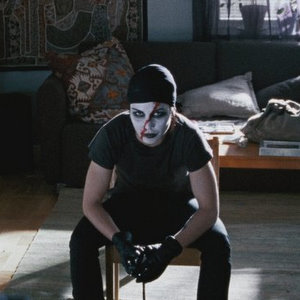
Lisbeth Salander (Noomi Rapace) has spent the better part of a year living abroad, and has lost contact with Mikael Blomkvist (Michael Nyqvist), who’s now out of prison and back in charge of Swedish magazine Millennium. Blomvkist hires a young journalist who’s working on a story about high-level human trafficking and sex crimes, although the young man never sees his work published as both he and his girlfriend, who has used the testimony of sex slaves for her thesis, are executed. Nils Bjurman, the rapist and former legal guardian of Lisbeth’s, is also killed, leading police to suspect the murderer is Lisbeth herself – Lisbeth’s fingerprints are on the gun found at the scene, although only we are aware that she visited Bjurman the previous night and threatened him with his own weapon – but did not kill him. Blomkvist, who doesn’t believe Lisbeth is the killer, begins to investigate the crimes himself, outside of the police jurisdiction, and ends up unearthing a more sinister, more widespread series of clues which have larger implications for people in government – Lisbeth, meanwhile, is investigating the case whilst in hiding, eventually learning that an old family conflict has once more reared its head, and she must confront those who seek to have her killed.
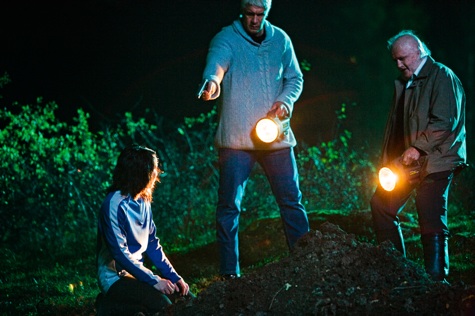
The Girl Who Played With Fire is a terrific film, let’s get that straight right now. As far as crime thrillers go, it’s up there with the best (as is the previous film in this trilogy), and it’s safe to say that this will keep you guessing right to the very end. The cast are superb, with Rapace and Nyqvist once more stepping into the well-worn shoes of their more famous characters, alongside a bunch of new faces. Also returning is the crew working at Millennium, the most relaxed work environment I’ve ever seen on film (really, do they do any work at all?), giving the actors returning for those roles a little more to do than they had the first time out. Peter Andersson’s slimy portrayal of Nils Bjurman finally gets the payoff he deserved, since his character practically vanished from the narrative midway through the first film. I did wonder what they had planned for him, and now I know. His part in this trilogy was just the beginning of what is turning out to be a long and terrible journey for our resident femme –gothale, Lisbeth. That’s a word I just made up, that is. I won’t be giving away too many spoilers here, for those who have yet to embrace this fascinating film trilogy, but as well as having a payoff for characters from the previous film, there’s folks introduced in this one who we’ll no doubt see more of in the third installment. It’s this complexity, this sense of a wider world outside the film itself, that I’ve been enjoying.
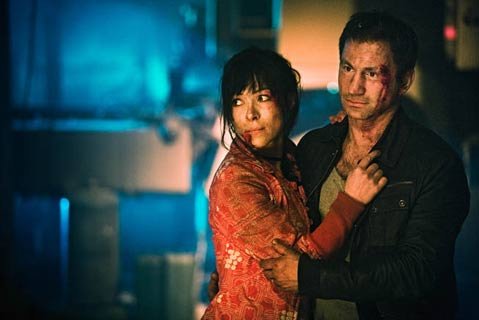
Director Daniel Alfredson takes the reins on this one, with Tattoo helmer Neils Arden Oplev stepping away from the camera this time – Alfredson has an incredibly similar aesthetic to Oplev, either that or the producers decided to try and maintain a sense of similarity between films so that audiences would understand that it’s all part of the larger story. It’s a lot like Harry Potter in that regard, in that no matter who the director was, you still knew it was a Harry Potter film. The same goes here, even if Alfredson’s command of the camera feels a little more TV-lite than effortless cinema. The framing, instead of the 2.40 aspect employed by Oplev in the previous film, is a less flamboyant 1.85 aspect here, with Alfredson going for a grittier, somewhat documentary style flavoring to this installment. There’s use of a lot more shadows and darkness; the lighting indicating just how much darker the film feels over the previous one, and it’s a well realized idea to do so. I think the films major failing, however, is keeping the two leads apart for almost the entire film. The fact that Blomkvist and Lisbeth don’t meet up until the final reel, about three minutes from the end, is a critical problem for the film, where there’s very little emotional payoff in their respective journeys. Blomkvist is searching for Lisbeth before the police can find her and arrest her, and Lisbeth is searching for the man responsible for her set-up, the mysterious Zala. Both storylines are interwoven, and the two of them do communicate (albeit through secondary sources), but the fact they don’t actually have a face-to-face confrontation in this film limits the emotional release the film’s spent the past two hours developing.
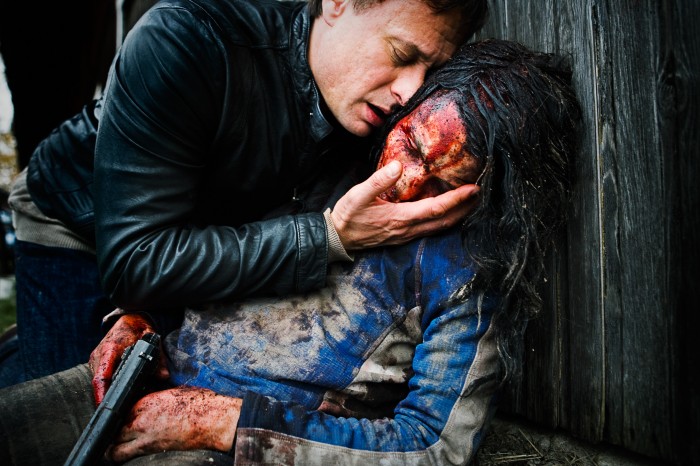
As with the previous film, The Girl Who Played With Fire moves along at a fairly slow pace, and this might put off those who’re seeking a more action-packed saga to enjoy; mind you, if you’ve already made it through The Girl With The Dragon Tattoo, you’ll have some idea what you’re getting into here, so it should come as no surprise to most. The Girl Who Played With Fire is an effective, slightly flawed mid-quel – a sequel in the middle – that brings to light some critical information which will make the concluding film a most interesting watch indeed. I really enjoyed this film, and can recommend it as another top class entry into this crime thriller genre, even if there’s a sense of “to be continued” about it, which could work against it. It’s an excellent film indeed.


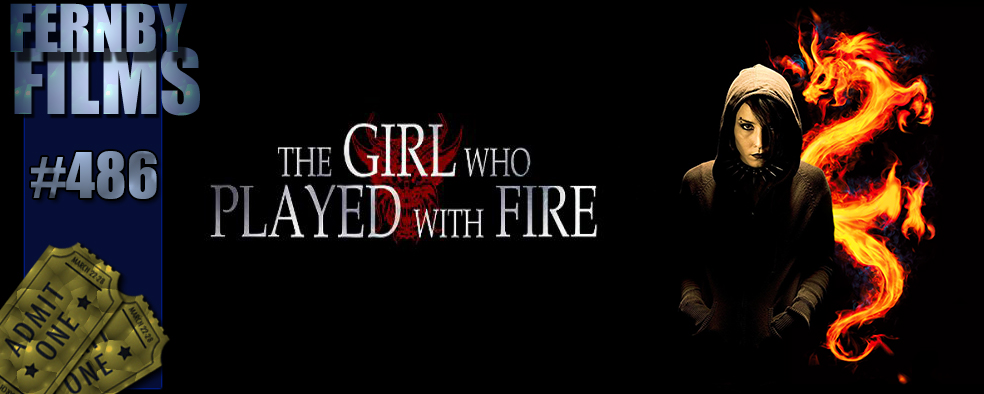
 Film Review: The Girl Who Played With Fire
Film Review: The Girl Who Played With Fire Film Review: The Girl Who Played With Fire
Film Review: The Girl Who Played With Fire The Girl Who Played With Fire on The Big Screen at The Strand Theater
The Girl Who Played With Fire on The Big Screen at The Strand Theater



I thought this one was the best of the three, but I didn't really care for any of them. I could never get involved in the stories for some reason. I liked the story, but I thought it was presented somewhat poorly, but I think that's more a case of me zoning out from boredom and then trying to jump back in without understanding or knowing who all the people were. I figured I'd get it sooner or later, but I really went through all three of these almost completely lost. I felt like you needed to have read the books to decipher some of it. I don't know. Good review though, and it gives me a feeling that I should try again. Maybe I'll give the Fincher version a shot.
@willsilver Hmm, see, I don't think an appreciation of the original books is required for enjoying these films, although it'd certainly help. For a newbie coming to these films, i'd suggest watching them all in a single sitting, or at least as close as possible one after the other where you can, because the subtle links between each film is more easily identifiable…. There's a lot to like in each film, and the characters (to me) are pretty elegantly performed by the cast – generally speaking – and seeing as how I'm usually the first to admit I don't always get the subtleties of twisty films like these, I actually came away quite pleased with myself for "getting" them fairly easily.
Give the Fincher film a shot, if only as a comparison. I'd suggest revisiting all three of the original Swedish films after a break and see how you go again. Oh, and you really need to be in the right mood to watch these films, too, I think. Thanks Will!!!
Best poster of the lot. Just sayin'.
@AlKHall I hear ya!
This, for me, was the weakest in the bunch. I missed the great chemistry between the two main leads as they spend most of their screen time apart
@FrontRoomCinema Yeah, that was a pretty big peeve for me on this one too, as I mentioned in my final paragraph. I think the third one is the weakest, however, because it didn't quite to justice to the story begun in the previous films. Thanks for stopping by, man!!